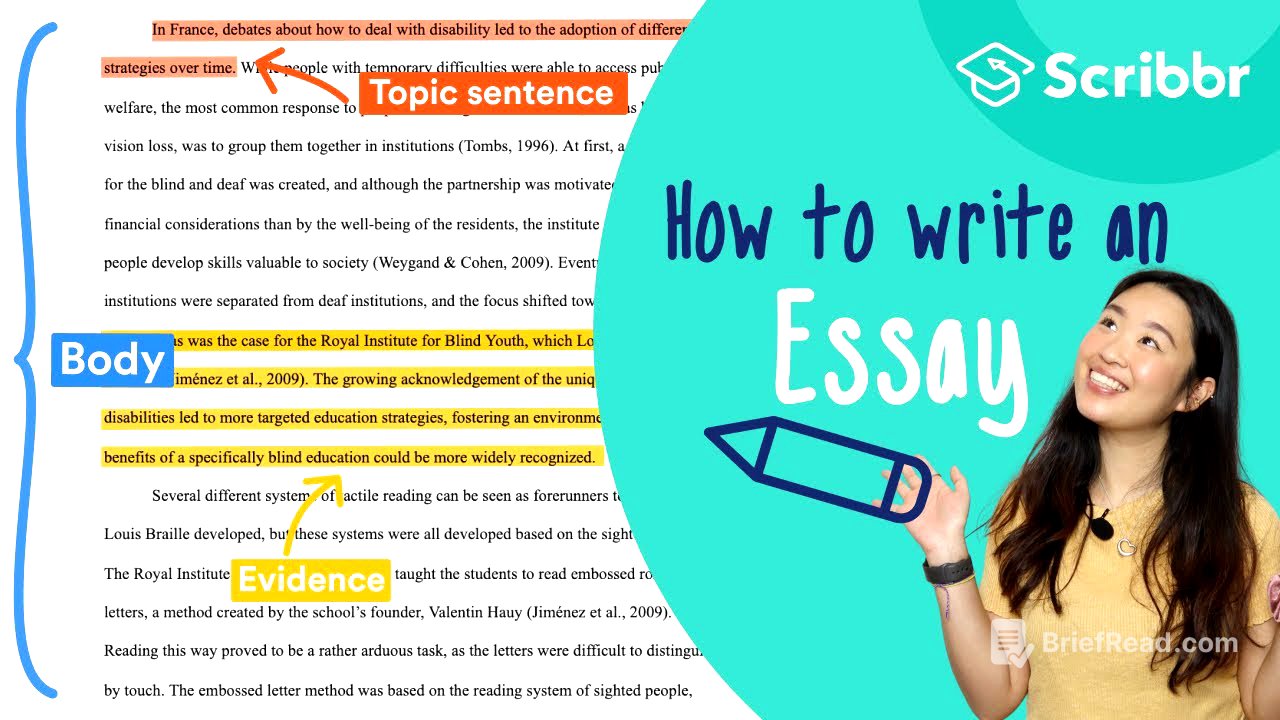TLDR;
This video provides a crash course on essay writing, covering the three main stages: preparation, writing, and revision. It explains how to develop a strong thesis, structure the essay with an introduction, body paragraphs, and conclusion, and revise the work for clarity, grammar, and plagiarism.
- Preparation involves understanding the assignment, choosing a topic, and creating an initial thesis.
- The writing stage includes crafting an engaging introduction with a clear thesis statement, developing arguments in the body paragraphs with evidence, and writing a conclusion that summarizes the main points.
- Revision focuses on checking arguments, grammar, spelling, formatting, and ensuring proper citation to avoid plagiarism.
Introduction [0:00]
The video introduces a comprehensive guide to essay writing, designed to equip viewers with the skills to write effective academic essays. It highlights that the goal of an academic essay is to persuade readers of a particular viewpoint through well-supported arguments, evidence, and analysis. The video outlines the three main stages of essay writing: preparation, writing, and revision, promising a detailed exploration of each stage in the subsequent videos.
Preparation Stage [0:49]
The preparation stage involves understanding the assignment and selecting a topic. After choosing a topic, the next step is to develop an initial thesis statement, which is the central argument or position the essay will defend. While the initial thesis doesn't need to be perfectly phrased at this stage, it should clearly outline the essay's main point. Finally, creating an outline is crucial for planning the essay's structure, which helps to initiate the writing process and maintain focus.
Writing: Introduction [1:24]
The writing stage begins with the introduction, which should immediately capture the reader's attention and inform them of the essay's scope. The introduction should start with an engaging hook, followed by context that helps the reader understand the argument. This context may include background information, an overview of relevant academic work or debates, and definitions of key terms. The thesis statement, developed during the preparation stage, should be presented to clearly state the essay's central argument, and the introduction can conclude with an overview of the essay's structure, effectively signposting what is to come.
Writing: Body [2:17]
The body of the essay, typically comprising 60-80% of the total length, is where the arguments supporting the thesis are presented, along with evidence and detailed explanations. To maintain clarity and structure within this substantial section, it is essential to organize the content into paragraphs, each focusing on a single argument or idea. Topic sentences should be used to introduce the purpose of each paragraph, providing a transition from the previous paragraph and setting up the argument to be made. Evidence, such as data, examples, or quotes, should be presented after the topic sentence, followed by interpretation and explanation to demonstrate how the evidence supports the overall argument.
Writing: Conclusion [3:09]
The conclusion is the final paragraph of the essay and serves to summarize and integrate the main points made in the body. It should highlight the outcome of the arguments, emphasizing any new insights gained, and underscore the significance of the argument presented. The conclusion ties together all the threads of the essay, leaving the reader with a clear understanding of the essay's purpose and findings.
Revision [3:31]
The revision stage is crucial for refining and polishing the essay before submission. This involves double-checking the arguments to ensure they are fully developed and well-structured, and restructuring any points that need improvement. Additionally, it is important to review the grammar, spelling, and formatting of the essay. If sources have been cited, a plagiarism checker should be used to verify that all citations are correct and that the work is original.
